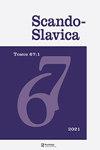From the editor
IF 0.2
0 HUMANITIES, MULTIDISCIPLINARY
引用次数: 0
Abstract
This issue of QMMR is all about good fits. The theme is an important one. A lot of what we do as researchers centers around this goal. Where will I study political science? (Which program is the right fit?) How can I understand this research problem? (Is there a good theoretical fit for this topic?) Identifying the appropriate method for answering the research question at hand is an integral component of the early stages of any research project. It is, in other words, about finding the right methodological fit. The right methodological fit may not be obvious. It may also be controversial. Take, for example, the pursuit of data transparency in political science. The ethical and practical ramifications of transparency have been debated widely. This is for good reason. The practice is not always appropriate and therefore should not be universally promoted. Debate is also fundamentally important for methodological praxis. However, this issue of QMMR sets the debate aside to acknowledge, quite simply, that many qualitative scholars are committed to making their research more transparent. This issue offers a set of case studies on how to undertake transparent qualitative research successfully and effectively. These case studies come from transparency practitioners with different epistemological perspectives and who use a variety of methods. Transparency, as the introduction succinctly highlights, is not a “‘one size fits all’ proposition.” The essays, therefore, offer a variety of strategies for fitting the goal of transparency into different types of qualitative research projects. The issue also provides insight on a challenging practical problem associated with spatial analysis. Many of the groups, units, and areas that we study do not easily conform to formally recognized borders. Consequently, it is often very difficult to fit the unit of analysis to the shape files available. The original article included in this issue explores different qualitative and mixed methods techniques that can be used to construct more accurate shape files for the “non-jurisdictional units”—gangs, immigration patterns, religious or ethnic groups, neighborhoods—that so often are the object of our research. The authors ask: How can we better fit the spatial analysis to the research at hand? They explore a variety of techniques that can be used to achieve this goal. I would like to close out my letter with an appeal to our readers, and especially to junior scholars and graduate students: If you have an idea for a symposium or an original article that engages with the use of qualitative and mixed methods, please send it to QMMR! You may not be sure that your idea or article is appropriate—in other words, you may worry about its fit, heh, heh, heh—but I encourage you to send it anyway. QMMR is a great opportunity to circulate methodological innovations in a shorter and therefore more accessible format. I hope to hear from you soon!来自编辑
本期《QMMR》讨论的都是合适的产品。主题很重要。作为研究人员,我们所做的很多工作都围绕着这个目标。我将在哪里学习政治学?(哪个项目最适合你?)我该如何理解这个研究问题?(是否有一个很好的理论适合这个主题?)确定合适的方法来回答手头的研究问题是任何研究项目早期阶段不可或缺的组成部分。换句话说,就是找到合适的方法。正确的方法可能并不明显。这也可能引起争议。以追求政治科学数据透明度为例。透明度的伦理和实际影响一直存在广泛的争论。这是有充分理由的。这种做法并不总是合适的,因此不应该普遍推广。辩论对于方法论实践也是至关重要的。然而,QMMR的这个问题将争论搁置一边,很简单地承认,许多定性学者致力于使他们的研究更加透明。本期提供了一系列关于如何成功有效地进行透明定性研究的案例研究。这些案例研究来自具有不同认识论观点的透明度实践者,他们使用各种方法。正如引言所简洁强调的那样,透明度并不是“一刀切”的命题。因此,文章提供了各种策略,以适应透明度的目标到不同类型的定性研究项目。该问题还提供了与空间分析相关的一个具有挑战性的实际问题的见解。我们研究的许多群体、单位和地区不容易符合正式承认的边界。因此,通常很难将分析单元与可用的形状文件相匹配。本刊的原始文章探讨了不同的定性和混合方法,这些方法可以用来为“非管辖单位”——帮派、移民模式、宗教或种族群体、社区——构建更准确的形状文件,这些通常是我们研究的对象。作者问:我们如何才能更好地将空间分析与手头的研究结合起来?他们探索了各种可以用来实现这一目标的技术。最后,我想对我们的读者,尤其是初级学者和研究生提出一个呼吁:如果你有一个关于使用定性和混合方法的研讨会或原创文章的想法,请发送给QMMR!你可能不确定你的想法或文章是否合适——换句话说,你可能担心它是否合适,嘿嘿,嘿嘿——但我鼓励你无论如何都要发送它。QMMR是一个很好的机会,以更短、因此更容易获得的格式传播方法创新。我希望能尽快收到你的来信!
本文章由计算机程序翻译,如有差异,请以英文原文为准。
求助全文
约1分钟内获得全文
求助全文

 求助内容:
求助内容: 应助结果提醒方式:
应助结果提醒方式:


